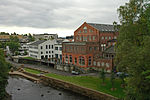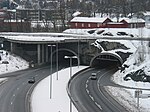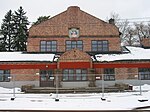Lysaker Station

Lysaker Station (Norwegian: Lysaker stasjon) is a railway station on the Drammen Line and Asker Line situated at Lysaker in Bærum, Norway. Located 7.00 kilometers (4.35 mi) from Oslo Central Station, Lysaker is served by a mix of Vy express, regional and Oslo Commuter Rail trains, as well as Flytoget. The station is elevated and features two island platforms with four tracks. It's the terminus of the Asker Line. Lysaker was one of two original Drammen Line station in Bærum, opening on 7 October 1872. The original station building, designed by Georg Andreas Bull, burned down in 1914 and was replaced by a new station Adalbert Kielland. In the following years the elevated and double-track layout was introduced. This station arrangement was demolished in 1987 to make way for a station designed by Arne Henriksen. Traditionally only served by commuter trains, the station was branded as Lysaker/Fornebu from 1990 to 2000 because of its vicinity to Oslo Airport, Fornebu. The station was rebuilt again from 2006 to 2009 in which it was expanded from two to four tracks. It became connected to the Asker Line in 2011.
Excerpt from the Wikipedia article Lysaker Station (License: CC BY-SA 3.0, Authors, Images).Lysaker Station
Elveveien, Bærum
Geographical coordinates (GPS) Address Nearby Places Show on map
Geographical coordinates (GPS)
| Latitude | Longitude |
|---|---|
| N 59.913611111111 ° | E 10.635833333333 ° |
Address
Elveveien
0283 Bærum, Lysaker
Norway
Open on Google Maps









